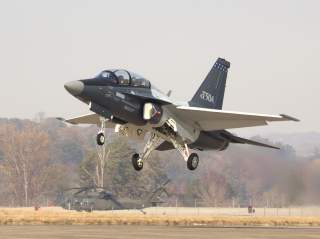T-X Competition Shows the Strength of America's Aerospace Industry
The Air Force may find it difficult to choose among the array of integrated solutions being offered.
A major issue for U.S. defense planners looking to an intensifying competition for military overmatch vis-à-vis prospective high-end adversaries, is the shrinking U.S. aerospace and defense sector. Decades of consolidation, driven by declining defense budgets, increasingly onerous regulations, the scarcity of major new programs, the war on profits and an unpredictable customer, has reduced the number of competitors in the major product lines to less than a handful of prime contractors. Below this level, the supply chain has thinned out to a degree that has logisticians and the operations and maintenance (O&M) establishment extremely worried. The once vaunted “Arsenal of Democracy” is or may soon be no more.
An example of the problems impacting the aerospace industrial base is the program to replace the T-38 jet trainer. Challenged by reductions in defense budgets and rising O&M costs, the Air Force delayed initiating a competitive procurement for a new jet trainer for years. The current platform, the T-38 Talon, is a lightweight, twin-seat supersonic jet. Production of the T-38 stopped in the early 1970s, resulting in a fleet that is on average nearly 50 years old. Despite major upgrades over the years, the T-38 is not expected to be cost-effective to operate much beyond 2020. In addition, the increased sophistication of modern combat aircraft such as the F-22 and F-35 necessitates a more capable trainer in order to ease pilots’ transition from basic training to operational units. It is imperative that the Air Force acquire a replacement for this obsolescent platform.
The Air Force has finally decided to replace the aging T-38 and associated flight simulators and training aides. Because it is one of only a handful of major military aircraft procurements expected in the next decade, the competition for the new Air Force trainer, the T-X, has generated enormous interest from the U.S. aerospace community. Whichever company wins the Air Force competition for some 350 aircraft also expects to be able to sell its aircraft internationally.
So it is reassuring, even remarkable, when a major new procurement program is able to attract no fewer than four serious competitors, perhaps more. These include this nation’s premier aircraft design and production companies, Boeing and Lockheed Martin, as well as Leonardo DRS (formerly Finmeccanica) and Sierra Nevada Corporation. Each company, along with their teammates, is offering a complete solution, including flight simulators and training aides as well as an advanced aircraft. Several other prominent aerospace companies considered entering the competition but chose not to bid for a variety of reasons.
The Boeing Company together with Swedish aerospace company SAAB, is proffering a clean sheet design. Its offering is a sleek, twin-tailed, single engine, supersonic platform designed, according to the company, with the goal of facilitating pilots’ transition to fifth-generation aircraft as well as ease of maintenance. Boeing has built two prototypes, one of which is already flying. The Boeing-led team also will provide state-of-the-art ground-based training systems.
Lockheed Martin, teamed with Korea Aerospace Industries, is proposing a variant of the latter’s T-50 Golden Eagle. This is a two seater, single engine, supersonic aircraft. The T-50 is currently operated as an advanced trainer by the South Korean Air Force and a number have been purchased by Indonesia, Thailand and the Philippines. The Lockheed Martin team is enhancing the T-50 with an aerial refueling capability, advanced avionics and displays, and an advanced, embedded ground training system.
A team led by Leonardo DRS, supported by CAE USA, is offering a version of the Alenia Aermacchi M-346 plus ground-based flight simulators under the banner of the T-100 Integrated Training System. The T-100 is a twin engine aircraft. Israel, the United Arab Emirates, Singapore, Poland and the Italian Air Force have all acquired the M-346 as an advanced trainer/light attack aircraft.
The fourth competitor is Sierra Nevada Corporation (SNC) teamed with Turkish Aerospace Industries (TAI). This team is proposing a clean-sheet design called the Freedom Trainer, described as a lightweight, twin engine, two seat, all composite aircraft. The SNC/TAI team has yet to unveil a prototype of its proposed candidate.
The Air Force is quite fortunate to have four serious competitors for the T-X program, including two of the biggest and most sophisticated aircraft builders in the world, Boeing and Lockheed Martin. This speaks to a degree of strength and innovativeness in the U.S. and allied aerospace industries. The Air Force may find it difficult to choose among the array of integrated solutions being offered.
Dr. Dan Goure is a Vice President of the Lexington Institute. He served in the Pentagon during the George H.W. Administration and has taught at Johns Hopkins and Georgetown Universities and the National War College. You can follow him on twitter @dgoure and you can follow the Lexington Institute @LexNextDC.
Image: Lockheed Martin

